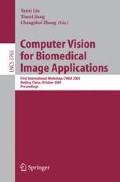Abstract
Important attributes of 3D brain segmentation algorithms include robustness, accuracy, computational efficiency, and facilitation of user interaction, yet few algorithms incorporate all of these traits. Manual segmentation is highly accurate but tedious and laborious. Most automatic techniques, while less demanding on the user, are much less accurate. It would be useful to employ a fast automatic segmentation procedure to do most of the work but still allow an expert user to interactively guide the segmentation to ensure an accurate final result.
We propose a novel 3D brain cortex segmentation procedure utilizing dual-front active contours, which minimize image-based energies in a manner that yields more global minimizers compared to standard active contours. The resulting scheme is not only more robust but much faster and allows the user to guide the final segmentation through simple mouse clicks which add extra seed points. Due to the global nature of the evolution model, single mouse clicks yield corrections to the segmentation that extend far beyond their initial locations, thus minimizing the user effort. Results on 15 simulated and 20 real 3D brain images demonstrate the robustness, accuracy, and speed of our scheme compared with other methods.
Access this chapter
Tax calculation will be finalised at checkout
Purchases are for personal use only
Preview
Unable to display preview. Download preview PDF.
References
Kass, M., Witkin, A., Terzopoulos, D.: Snakes: Active contour models. International Journal of Computer Vision 1, 321–332 (1988)
Malladi, R., Sethian, J.: A geometric approach to segmentation and analysis of 3d medical images. In: Processings of Mathematical Methods in Biomedical Image Analysis, MMBIA 1996 (1996)
Davatzikos, C., Bryan, R.: Using a deformable surface model to obtain a shape representation of the cortex. IEEE Trans. on Medical Imaging 15, 785–795 (1996)
Teo, P., Sapiro, G., Wandell, B.: Creating connected representations of cortical gray matter for functional mri visualization. IEEE Trans. on Medical Imaging 16, 852–863 (1997)
Dale, A., Fischl, B., Sereno, M.: Cortical surface-based analysis. NeuroImage 9, 179–194 (1999)
Xu, C., Pham, D., Rettmann, M., Yu, D., Prince, J.: Reconstruction of the human cerebral cortex from magnetic resonance images. IEEE Trans. on Medical Imaging 18, 467–480 (1999)
Zeng, X., Staib, L., Schultz, R., Duncan, J.: Segmentation and measurement of the cortex from 3D MR images using coupled surfaces propagation. IEEE Transactions on Medical Imaging 18, 100–111 (1999)
Goldenberg, R., Kimmel, R., Rivlin, E., Rudzsky, M.: Cortex segmentation: A fast variational geometric approach. IEEE Trans. on Medical Imaging 21, 1544–1551 (2002)
Pham, D., Prince, J.: Adaptive fuzzy segmentation of magnetic resonance images. IEEE Trans. on Medical Imaging 18, 737–752 (1999)
Liew, A., Yan, H.: An adaptive spatial fuzzy clustering algorithm for 3d mr image segmentation. IEEE Trans. on Medical Imaging 22, 1063–1075 (2003)
Marroquin, J., Vemuri, B., et al.: An accurate and efficient bayesian method for automatic segmentation of brain mri. IEE Trans. on Medical Imaging 21, 934–945 (2002)
Zhang, Y., Brady, M., Smith, S.: Segmentation of brain mr images through a hidden markov random field model and the expectation maximization algorithm. IEEE Trans. on Medical Imaging 20, 45–57 (2001)
Ruan, S., Moretti, B., Fadili, J., Bloyet, D.: Fuzzy markovian segmentation in application of magnetic resonance images. Computer Vision and Image Understanding 85, 54–69 (2002)
Leemput, K.V., Maes, F., Vandermeulen, D., Suetens, P.: Automated model-based tissue classification of mr images of the brain. IEEE Trans. on Medical Imaging 18, 897–908 (1999)
Kapur, T., Grimson, W., et al.: Segmentation of brain tissue from magnetic resonance images. Medical Image Analysis 1, 109–127 (1996)
Li, H., Elmoataz, A., Fadili, J., Ruan, S.: Dual front evolution model and its application in medical imaging. In: Barillot, C., Haynor, D.R., Hellier, P. (eds.) MICCAI 2004. LNCS, vol. 3216, pp. 103–110. Springer, Heidelberg (2004)
BrainWeb: Mcconnell brain imaging center, montreal neurological institute, http://www.bic.mni.mcgill.ca/brainweb/
Bezdek, J.: Pattern Recognition with Fuzzy Objective Functions Algorithms. Plenum (1981)
Cocosco, C., Kollokian, V., Kwan, R., Evans, A.: Brainweb: Online interface to a 3D MRI simulated brain database. NeuroImage 5, S425 (1997)
Perona, P., Malik, J.: Scale-space and edge detection using anisotropic diffusion. IEEE Trans. on PAMI 12, 629–639 (1990)
Filipek, P., Richelme, C., Kennedy, D., Caviness, V.: The young adult human brain: an mri-based morphometric analysis. Cerebral Cortex 4, 344–360 (1994)
Author information
Authors and Affiliations
Editor information
Editors and Affiliations
Rights and permissions
Copyright information
© 2005 Springer-Verlag Berlin Heidelberg
About this paper
Cite this paper
Li, H., Yezzi, A., Cohen, L.D. (2005). Fast 3D Brain Segmentation Using Dual-Front Active Contours with Optional User-Interaction. In: Liu, Y., Jiang, T., Zhang, C. (eds) Computer Vision for Biomedical Image Applications. CVBIA 2005. Lecture Notes in Computer Science, vol 3765. Springer, Berlin, Heidelberg. https://doi.org/10.1007/11569541_34
Download citation
DOI: https://doi.org/10.1007/11569541_34
Publisher Name: Springer, Berlin, Heidelberg
Print ISBN: 978-3-540-29411-5
Online ISBN: 978-3-540-32125-5
eBook Packages: Computer ScienceComputer Science (R0)

